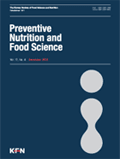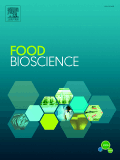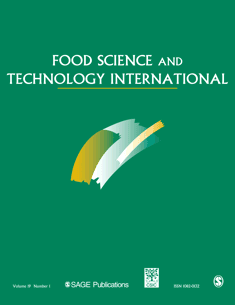
Foods
Scope & Guideline
Innovating Research for a Healthier Tomorrow.
Introduction
Aims and Scopes
- Food Safety and Microbiology:
Research in this area addresses the prevention of foodborne pathogens, the effectiveness of preservation methods, and risk assessments related to microbiological safety in various food products. - Nutritional Science and Health Benefits:
This scope emphasizes the nutritional composition of food products, the bioactive compounds they contain, and their potential health benefits, including studies on dietary interventions and the effects of food matrices on health outcomes. - Food Technology and Processing Innovations:
The journal publishes studies on new processing techniques, innovative food formulations, and the development of functional foods that enhance nutritional value and sensory attributes. - Consumer Behavior and Food Perception:
This area explores consumer attitudes, preferences, and behaviors related to food choices, including the acceptance of novel foods and the influence of packaging and labeling on consumer decisions. - Sustainable Food Practices:
Research focusing on the sustainability of food production, waste valorization, and the use of alternative ingredients, such as plant-based proteins and by-products from food processing. - Functional Ingredients and Additives:
Investigations into the role of various food additives, including natural extracts, polysaccharides, and proteins, and their impact on food quality, safety, and health benefits.
Trending and Emerging
- Plant-Based and Alternative Proteins:
There is a significant rise in research focused on plant-based proteins and meat alternatives, driven by consumer demand for sustainable and health-conscious food options. This trend highlights innovations in food technology, such as the use of legumes and insects as protein sources. - Functional Foods and Bioactive Compounds:
Emerging interest in the health benefits of functional foods, particularly those enriched with bioactive compounds, is evident. Research is increasingly focusing on how these compounds can prevent chronic diseases and improve overall health. - Food Waste Valorization:
Research addressing the sustainable management of food waste and the conversion of by-products into valuable food ingredients is gaining momentum, reflecting a broader commitment to sustainability in food systems. - Food Authenticity and Traceability:
With growing concerns about food fraud and safety, research into methods for ensuring the authenticity and traceability of food products is on the rise, utilizing advanced technologies such as DNA barcoding and machine learning. - Consumer Health and Food Choices:
The intersection of consumer behavior and health implications of food choices is increasingly being explored, particularly in the context of dietary trends and public health initiatives.
Declining or Waning
- Traditional Food Preservation Methods:
Research on conventional preservation techniques, such as canning and salting, has decreased as newer, more innovative methods gain traction, such as high-pressure processing and cold plasma treatments. - Animal-Based Food Products:
The emphasis on research related to traditional animal-based products appears to be waning, as there is a growing focus on plant-based alternatives and sustainable protein sources. - Chemical Additives and Synthetic Preservatives:
Papers concentrating on synthetic additives and preservatives have become less prevalent, likely due to increasing consumer preference for clean-label products and natural alternatives. - Regional and Traditional Foods:
The exploration of specific regional and traditional foods is becoming less common as the journal shifts towards broader, globally relevant food science topics and innovations. - Single Nutrient Studies:
Research focusing solely on individual nutrients is declining, with a growing preference for studies that consider the overall dietary patterns and their holistic effects on health.
Similar Journals

Future Foods
Innovating tomorrow's food solutions today.Welcome to Future Foods, a cutting-edge academic journal published by Elsevier, dedicated to advancing the field of food science. As a prestigious Q1 journal in the Food Science category, it ranks impressively as #43 out of 389 in Scopus, placing it in the 89th percentile among its peers. Future Foods aims to explore innovative developments in sustainable food systems, novel food products, and the intersection of technology and food production, thus providing a platform for research that addresses global challenges such as food security and nutrition. With its focus on future-oriented solutions and trends in the food industry, this journal is essential for researchers, professionals, and students who are eager to contribute to the discourse around cutting-edge food science. Situated in the Netherlands, the journal serves the international academic community and fosters collaboration and knowledge sharing in the realm of food innovation.

Acta Scientiarum Polonorum-Technologia Alimentaria
Championing Quality and Sustainability in Food TechnologyActa Scientiarum Polonorum-Technologia Alimentaria, published by Poznan University of Life Sciences, is a revered journal in the field of food science, showcasing cutting-edge research and innovations in food technology. Established as a leading platform within its domain, this journal is indexed under Scopus and ranks in the 2023 Q3 quartile for Food Science, demonstrating its commitment to high-quality scholarship. With an ISSN of 1644-0730 and E-ISSN 1898-9594, it serves as a critical resource for researchers, professionals, and students seeking to stay at the forefront of advancements in food safety, quality control, and sustainable practices. The journal has also been recognized for its contributions to the agricultural and biological sciences, positioning itself at rank #205 out of 389 in this competitive field. While currently not offering open access, the journal's valuable insights and findings, especially as it publishes through 2024, play a crucial role in advancing knowledge and fostering collaboration among experts in the food science sector.

Preventive Nutrition and Food Science
Empowering Evidence-Based Nutrition for Optimal WellbeingPreventive Nutrition and Food Science, an esteemed journal published by the Korean Society of Food Science and Nutrition, serves as a pivotal platform for the dissemination of innovative research and insights in the fields of food science, nutrition, and dietetics. With an ISSN of 2287-1098 and an E-ISSN of 2287-8602, this journal is dedicated to advancing knowledge from 2012 through 2024, showcasing contributions that reflect the interplay between nutrition, health, and preventive strategies. Indexed in Scopus, it proudly holds a Q2 ranking in Food Science and a Q3 ranking in Nutrition and Dietetics as of 2023, positioning it among influential publications within these disciplines. Researchers, professionals, and students can explore cutting-edge studies that contribute significantly to evidence-based practices, enhancing public health and nutritional care. Although it operates under a subscription model, the journal plays a crucial role in fostering a deeper understanding of preventive nutrition, advocating for advancements that address contemporary dietary challenges.

Food Bioscience
Unlocking Knowledge for Tomorrow's Food ChallengesFood Bioscience is a leading peer-reviewed journal published by Elsevier, dedicated to advancing the understanding of the complex interplay between food science and biosciences. With an impressive Impact Factor that places it in the Q1 and Q2 quartiles for Food Science and Biochemistry respectively, the journal consistently ranks among the top publications in its field, reflected in its Scopus rankings (Rank #83/389 in Food Science and Rank #175/438 in Biochemistry). Since its inception in 2013, Food Bioscience has fostered a multidisciplinary approach, bridging gaps between research in agricultural, biological, and food sciences, thus encouraging innovative solutions to the pressing challenges facing the global food supply chain. Although it currently operates under a subscription model, the journal is committed to disseminating high-quality research, making significant contributions to both academic scholarship and industry practices. Researchers, professionals, and students alike are invited to explore the wealth of knowledge contained within its pages as it plays a pivotal role in shaping the future of food bioscience.

Journal of Food Science and Technology-Ukraine
Championing the Future of Food Technology and SafetyJournal of Food Science and Technology-Ukraine, published by the Odesa National University of Technology, stands as a pivotal platform dedicated to the dissemination of high-quality research in the field of food science and technology. With its open access policy established in 2014, the journal fosters global knowledge sharing and accessibility, enabling researchers, professionals, and students to access critical findings and advancements in food technology without barriers. The journal's commitment to publishing innovative studies, reviews, and case analyses reinforces its role in addressing contemporary challenges in food safety, preservation, processing, and nutritional quality. With ISSN 2073-8684 and E-ISSN 2409-7004, it serves as a valuable resource for the academic community, supporting the advancement of food science knowledge and its practical applications.

FOOD REVIEWS INTERNATIONAL
Exploring Innovations for a Sustainable Food FutureFOOD REVIEWS INTERNATIONAL, published by Taylor & Francis Inc, serves as a pivotal resource within the fields of Food Science and Chemical Engineering. Established in 1985, this esteemed journal offers a comprehensive platform for the dissemination of critical reviews that enhance understanding and innovation in the food industry. With an impressive impact factor reflecting its Q1 quartiles in both Food Science and Chemical Engineering categories, it ranks among the top journals in Scopus, securing the 24th spot in Agricultural and Biological Sciences. Scholars, researchers, and professionals are encouraged to explore its rich content, which spans meticulously reviewed articles that bridge academic research and practical applications, while contributing to advancements in food safety, processing, and sustainability. Although not an Open Access journal, access to its extensive repository is vital for anyone aiming to stay at the forefront of food science advancements.

NFS Journal
Championing open access to vital food and nutrition insights.NFS Journal, published by ELSEVIER, is at the forefront of research in the fields of Food Science and Nutrition and Dietetics, boasting an impressive impact factor that underscores its significance. With an Open Access model since 2015, the journal facilitates widespread dissemination and accessibility of high-quality research, making it a valuable resource for scholars and practitioners alike. Located in Germany, this journal has made its mark with its prestigious Q1 ranking in both Food Science and Nutrition and Dietetics as of 2023, positioning it among the top-tier journals in these disciplines. Additionally, it holds an outstanding standing in Scopus rankings, being placed at 10th out of 140 in Nutrition and Dietetics and at 27th out of 389 in Food Science, reflecting its influence and reach within the global academic community. The NFS Journal is dedicated to publishing the latest advancements and practices that shape our understanding of the relationship between food, health, and nutrition, appealing to researchers, professionals, and students eager to stay updated with novel insights and breakthroughs.

Current Research in Food Science
Exploring Innovations in Culinary ResearchCurrent Research in Food Science is a leading peer-reviewed academic journal published by Elsevier, specializing in the dynamic field of food science. Since its transition to an Open Access model in 2019, the journal has broadened its reach, contributing significantly to the dissemination of high-quality research. With strong rankings, including a Q1 quartile status in Applied Microbiology and Biotechnology, Biotechnology, and Food Science, it stands out as a pivotal resource for scholars. Based in the Netherlands, current research published within its pages spans a wide range of relevant topics, ensuring that researchers and practitioners stay abreast of the latest advancements. The journal's impressive Scopus rankings enhance its credibility, with a percentile standing in the 74th to 83rd range across relevant categories, underscoring its impact and importance in the academic community. Current Research in Food Science aims to foster the exchange of innovative ideas and foster collaborative efforts among researchers, making it an essential resource for those engaged in advancing the science and technology of food.

FOOD SCIENCE AND TECHNOLOGY INTERNATIONAL
Championing interdisciplinary studies in food systems.FOOD SCIENCE AND TECHNOLOGY INTERNATIONAL, published by SAGE Publications Ltd, is a premier journal in the fields of food science and technology, serving as a crucial platform for the dissemination of innovative research and practical applications from 1995 through to 2024. With an impact factor reflecting its significant standing—ranking in the Q2 quartile for Chemical Engineering, Food Science, and Industrial and Manufacturing Engineering—this journal plays an instrumental role in advancing the interdisciplinary study of food systems. Researchers, professionals, and students can access high-quality contributions that address the latest developments and trends in food technology, safety, and processing. Located in the United States, FOOD SCIENCE AND TECHNOLOGY INTERNATIONAL also boasts commendable Scopus rankings, ensuring its articles are both relevant and widely cited within the academic community. As a vital resource for anyone engaged in food science research, этот журнал fosters knowledge sharing and innovation in the ever-evolving landscape of food technology.

Applied Food Research
Elevating Food Science Through Pioneering ResearchApplied Food Research, published by Elsevier, is an esteemed journal that plays a critical role in advancing the field of Food Science. With an ISSN of 2772-5022, the journal has established itself as a premier outlet for high-quality research, achieving a commendable Q1 ranking in the 2023 Food Science category and a 63rd percentile in Scopus rankings for Agricultural and Biological Sciences. Covering a diverse range of topics from food safety to innovative processing techniques, Applied Food Research seeks to publish pioneering studies that enhance our understanding of food systems and contribute to broader discussions on sustainability and nutrition. As it converges on its fourth year of publication, researchers, professionals, and students alike are encouraged to engage with its content through various open access options, ensuring widespread dissemination of knowledge in a field that is vital to global health and well-being. Operating out of Amsterdam, Netherlands, this journal is poised to be an indispensable resource for anyone dedicated to making significant contributions in the domain of food science.